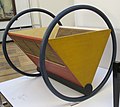Cradle

A cradle is a mostly wooden rocking bed for babies and toddlers. It is characteristic that this bed can be rocked from the outside and it is also moved by the child's own movements. It is generally believed that the rocking motion will calm the child.
The word "cradle" can also be used in a figurative sense and then denotes the place of origin of a thing or social phenomena.
History and forms
Certain forms of the cradle are already documented from premodern cultures, most of which are cradles. Movable cradles (e.g. roller cradles) were already used in ancient times. Numerous medieval and early modern images show that the babies were wrapped, that is, tightly constricted, and placed in these cradles. In addition, they were often held in place with tapes that were carried over the cradle, as the doctor Felix Würtz described in the 16th century. In his monograph on the cradle, Zglinicki shows numerous illustrations that have appropriate devices for tying babies. The straps used to tie the babies in the cradle are called cunarum vincula in Middle Latin, i.e. cradle shackles . Around 1800 a controversy arose about the health pros and cons of rocking and with the advent of rollaway beds and prams, the cradle disappeared from the community center, and it remained in use in the country. Cradles remained popular as dolls furniture well into the 20th century.
There are numerous forms of cradle in the sense of a carrying device. These cradles are known, for example, by the indigenous peoples of America as cradleboard (German: Wiegenbrett ). The cradleboard has some equivalents in Asian groups and also in the Sami, where this device is called Komse .
A special form of the cradle is the Japanese ejiko, a basket-like container in which the infant was tied and placed. The ejiko contains several layers of material to absorb the child's urine and feces. Some European and Middle Eastern cradles had drainage devices to allow babies' urine to drain.
Pentagrams or religious symbols were affixed to numerous European cradles, as they were often found on beds, doors, windows, buildings, etc. to ward off demons. The coat of arms of Groß Schwechten shows a cradle.
The Bauhaus student Peter Keler developed a modern cradle design in 1922 when he designed the Bauhaus cradle as a bed with a round tubular steel frame. From the middle of the 20th century , cradles were considered old-fashioned and outdated for a while, but in recent years they have experienced a renaissance.
A spring cradle is a cradle that is suspended from a steel spring and, in contrast to classic cradles or bassinets, does not rock back and forth, but up and down.
Antique illustration of a child in the cradle in Paestum
Cradle of Charles XII.
Cradle with pentagram on a gauntlet (ca.1770)
Old wickerwork cradle from the 19th century in Haus Cleff (local history museum) Remscheid
literature
in alphabetical order by authors / editors
- Ralph Frenken: Bound Children: History and Psychology of Swaddling . Scientific publishing house Bachmann. Badenweiler 2011.
- Mary Rosario Gorman: The nurse in Greek life (dissertation). Boston 1917.
- Peter Keller: The cradle of the Christ child. A household appliance in art and cult (= manuscripts for art history in the Werner publishing company 54). Wernersche Verlagsgesellschaft, Worms 1998. ISBN 978-3-88462-953-6
- Michio Kitahara: Childhood in Japanese Culture . In: The Journal of Psychohistory 17 (1/1989), pp. 43-72.
- Goro Kohno: History of Diapering in Japan . Pediatrician, 14 (Supplement 1/1987), pp. 2-5.
- Earle L. Lipton, Alfred Steinschneider, Julius B. Richmond: Swaddling, a Child Care Practice: Historical, Cultural, and Experimental Observations . In: Pediatrics, 35 (1965), pp. 521-567.
- Hermann Heinrich Ploß: The Child in Customs and Customs of the Nations . Ethnological studies 1st 3rd edition Leipzig 1911.
- Felix Würtz: Weiland of the famous surgeon in Basel Wund-Artzney / in which all sorts of harmful abuses (...) are indicated in detail and abolished for the sake of many significant causes (...). Inside: midwives and children's books . Basel 1675, pp. 674-730.
- Friedrich v. Zglinicki: The cradle. Folklore - cultural history - art history - medical history. A cradle typology with over 500 illustrations . Regensburg 1979. ISBN 3-7917-0622-5
See also
Web links
Individual evidence
- ↑ See Zglinicki (1979), p. 50. See Fig. 451 of a Greek baby in ancient times in a rolling cradle, and Fig. 404, also from ancient Greece. Gorman (1917), p. 22 f. describes several ancient cradle forms and their uses.
- ↑ See Frenken (2011), pp. 14, 69, 167, 217 and 219
- ↑ See Würtz (1563), p. 706.
- ↑ Cf. Zglinicki (1979), p. 51 ff. On wrapping in the cradle and illustrations including 28, 44, 58 (with corresponding holes in the cradle), Fig. 195, 198, 200–205 with tight wrapping over the bedding and Fig. 48–53 with knobs for fastening the cradle straps.
- ↑ See Frenken (2011), p. 9.
- ↑ See Ploß (1911), p. 277 and Fig. P. 278. Zglinicki (1979), Fig. 151 shows a hanging cradle of the seeds, which is very similar to a cradleboard.
- ↑ See Kohno (1987), p. 3 (with illustration), Kitahra (1989), p. 43 ff., Lipton et al. (1965), p. 524 f.
- ↑ See Dingwall (1931), p. 84, Zglinicki (1979), p. 48 f. See also Figures 2–6, which show drainage systems in cradles.
- ↑ Zglinicki (1979) shows cradles with symbolic defense against demons. Weighing with pentagram (dog's foot): Fig. 48–55; with the IHS symbol (Iesus Hominum Salvator = Jesus, savior of men) or other religious symbols such as the burning heart: Figs. 19–45, 331, 463, 468.







